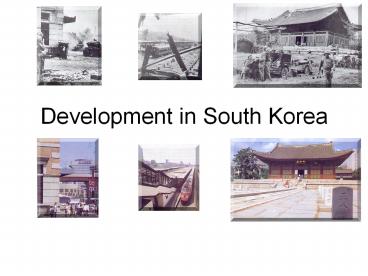Development in South Korea - PowerPoint PPT Presentation
Title:
Development in South Korea
Description:
Development in South Korea Japanese rule (1910-45) Control educational system Japanese language and culture Control land (40% of entire country) Infrastructure ... – PowerPoint PPT presentation
Number of Views:219
Avg rating:3.0/5.0
Title: Development in South Korea
1
Development in South Korea
2
(No Transcript)
3
(No Transcript)
4
Japanese rule (1910-45)
- Control educational system
- Japanese language and culture
- Control land (40 of entire country)
- Infrastructure
- railroads and telegraph lines
- Industrialization
- Provisional Government-in-exile (1919)
5
38th Parallel (1945-50)
- Soviet U.S. divided Korea along 38th parallel
after Japan surrendered in 1945 - 1948-08-15, Republic of Korea established
- 43 area, 60 population
- President Rhee Syngman
- 1948-09-09, Democratic Peoples Republic of Korea
established - Premier Kim Il-Sung
6
Dulles, Rhee, MacArthur
- nationalist goals vs. Cold War strategies
7
Korean War (1950 - 1953)
- Most fighting happened 1950 - 1951
- truce negotiations 1951 - 1953
- Military Demarcation Line (MDL) (1953 - )
8
Republic of Korea
- President Rhee Syngman (1948 - 60)
- autocrat resigned amid popular protests
- 1961 military coup by Park Chung-Hee
- relations with Japan normalized in 1965
- economic takeoff
- assassinated in 1979
- Army General Chun Doo Hwan (1980-7)
- 1980 Kwangju massacre
9
ROK Economic Takeoff
- Parks authoritarian rule (1961-79)
- annual economic growth rate of 9.2
- one of the four Asian little dragons
- year per capita GDP (US) export (US)
- 1962 87 56.7
million - 1980 1,503 17,500.0
million
10
Economic Takeoff Under President Park Chung-Hee
(1962-1979)
11
Development in South Korea
- Development a matter of survival
- high population density (48 mil./105km²)
- few natural resources
- external military threat
- one of the Four Tigers of East Asia
- an incredible record of growth
- integration into the high-tech modern world
economy
12
Development in South Korea
- During 1960s GDP per capita was comparable with
levels in the poorer countries of Africa and Asia - Today its GDP per capita is more than 20 times
North Korea's and comparable to that of the
European Union - Total GDP (p.p.p.) reached 2 trillion in 2017
(ranks 14th in the world)
13
Exports of Goods and Services ( of GDP) 1960-2017
14
(No Transcript)
15
Success through the late 1980s
- a system of close government-business ties
(chaebol) - directed credit
- import restrictions
- import of raw materials and technology
- at the expense of consumer goods
- sponsorship of specific industries
- a strong labor effort
16
Savings ratio
- savings and investment over consumption
- Savings 36 gt Japan 31 gt US 16
- Remains high even today
17
Small Social Spending
Public social expenditure ( GDP) Public social expenditure ( GDP) Public social expenditure ( GDP) Public social expenditure ( GDP) Public social expenditure ( GDP)
1980 1990 2000 2010
France 20.2 24.3 27.5 30.7
Germany 21.8 21.4 25.4 25.9
Japan 10.2 11.1 16.3 22.1
Korea 2.7 4.5 8.3
U.S. 12.8 13.2 14.3 19.3
18
Military Expenditure ( of GDP)
19
(No Transcript)
20
(No Transcript)
21
Trade Partners 2017
- Exports (0.6 trillion) to
- China 25
- US 12
- Vietnam 8
- Imports (0.5 trillion) from
- China 21
- Japan 12
- US 11
22
Asian financial crisis
- The Asian financial crisis of 1997 - 1998
- exposed longstanding weaknesses in South Korea's
development model - high debt/equity ratios
- massive foreign borrowing
- an undisciplined financial sector
23
(No Transcript)
24
Democratization in ROK
- 1987 election, former general Roh Tae Woo
defeated opposition leaders Kim Dae Jung and Kim
Young Sam - 1987, Declaration of Political Reforms
- 1988 election, opposition parties won majority in
National Assembly - Kim Young Sam won presidential election in 1992
(1st elected civilian president)
25
Former and Current President
- President Park Geun-hye (2013 - 2017)
- Daughter of former president Park Chung-hee
- President Moon Jae-in (2017 - present)































